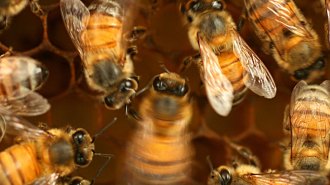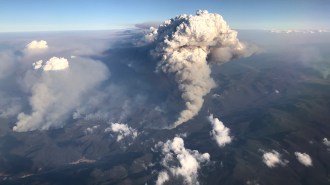Uncategorized
-
 Life
LifeHoneybees waggle to communicate. But to do it well, they need dance lessons
Young honeybees can’t perfect waggling on their own after all. Without older sisters to practice with, youngsters fail to nail distances.
By Susan Milius -
 Archaeology
ArchaeologySome monkeys accidentally make stone flakes that resemble ancient hominid tools
A study of Thailand macaques raises questions about whether some Stone Age cutting tools were products of planning or chance.
By Bruce Bower -
 Health & Medicine
Health & MedicineMy mammogram revealed I have dense breasts. What does that mean?
Nearly half of U.S. women have dense breasts. A new FDA rule makes notification of breast density national. Here’s the scoop on why.
-

-

Good with tools? You may be a cockatoo
Editor in chief Nancy Shute talks about smart animals, from tool-using cockatoos to "self-aware" fish.
By Nancy Shute -
 Astronomy
AstronomyA runaway black hole has been spotted fleeing a distant galaxy
A bright streak stretching away from a remote galaxy might be the light from stolen gas and new stars caught in the wake of an escaping black hole.
-
 Neuroscience
NeuroscienceScientists have mapped an insect brain in greater detail than ever before
Researchers have built a nerve cell “connectivity map” of a larval fruit fly brain. It’s the most complex whole brain wiring diagram yet made.
-
 Agriculture
AgricultureDry farming could help agriculture in the western U.S. amid climate change
Some farmers in the western United States are forgoing irrigation, which can save on water and produce more flavorful fruits and vegetables.
-
 Paleontology
Paleontology520-million-year-old animal fossils might not be animals after all
Newly described fossils of Protomelission gatehousei suggest that the species, once thought to be the oldest example of bryozoans, is actually a type of colony-forming algae.
By Sid Perkins -
 Climate
ClimateHow wildfires deplete the Earth’s ozone layer
Scientists detail the chain of chemical reactions that occur when wildfire smoke enters the stratosphere.
-
 Astronomy
AstronomyNewborn stars sculpt their galaxies in new James Webb telescope images
Dark voids riddle the galaxies’ faces, highlighting previously invisible details about how new stars alter their locales.
-
 Physics
PhysicsIs this the superconductor of scientists’ dreams? A new claim faces scrutiny
It’s big, if true: transmitting electricity with no resistance at room temperature and moderate pressure. But controversy dogs the team making the claim.
By Emily Conover and James R. Riordon